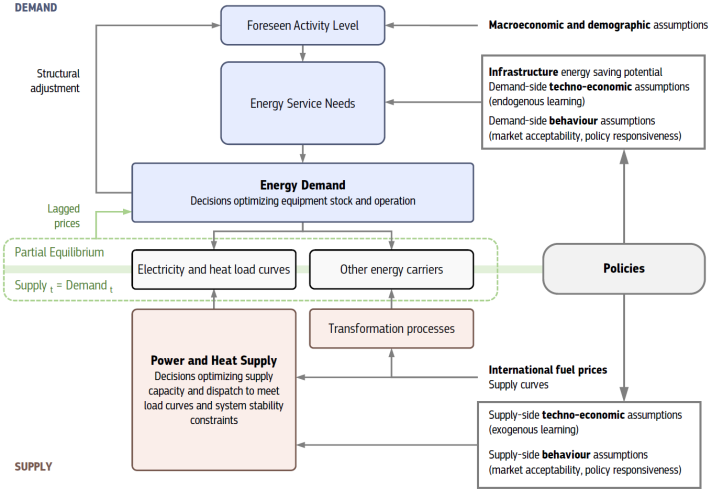POTEnCIA (the Policy Oriented Tool for Energy and Climate Change Impact Assessment) is an economic model designed to represent the supply of energy and all sectors of energy demand in the EU: industry, residential, services and agriculture, transport, and power and heat generation.
Overview
POTEnCIA represents each EU Member State individually with the option of addressing the EU27 energy system as a whole. It is designed to evaluate prospective or existing policies, generally by comparing scenarios that depict alternative energy and climate policy environments. To this end POTEnCIA:
- Realistically captures the adoption and use of new energy technologies under different policy conditions.
How? By simulating decision-making under imperfect foresight at a high level of techno-economic detail. - Provides high temporal detail to assess rapid structural changes in the EU’s energy system.
How? By combining a yearly simulation of demand-side investment with hourly resolution for the power sector. - Accurately represents the age and performance of installed energy equipment, and enables the assessment of stranded asset risks and retrofitting or retirement strategies.
How? By tracking yearly equipment stock vintages for energy supply and demand.
These features enable the joint analysis of technology-focused policies as well as policies addressing the decision-making of energy users. Model outputs are provided in annual time steps for 2000-2050; historical conditions (2000-2021) are consistent with Eurostat and based on the Joint Research Centre’s Integrated Database of the European Energy System (JRC-IDEES), which is publicly available and maintained in parallel to the POTEnCIA model.
Model structure
The core modelling structure of POTEnCIA (detailed in a scientific article) follows a recursive dynamic partial equilibrium approach, which successively optimises demand and supply across energy carriers in each year. This approach assumes that each demand sector requires a certain energy service to meet foreseen activity levels in a given year (such as tonnes of steel produced or mobility needs). This energy service is then met by optimising both the stock and use of energy-related equipment in each sector of energy supply and demand.
Establishing a representative agent
For each sector, this approach is implemented using a representative agent that seeks to maximize its benefit or minimize its cost under constraints such as available technologies and fuels, behavioural preferences, and climate policies. The agents represent the aggregate decisions of individual decision-makers (e.g. firms or households) and yield a representative consumption profile for each sector, in terms of energy-related equipment in use, consumer preferences, etc. This implementation is tailored to each sector, for instance to represent different planning horizons and expectations about future technologies under imperfect foresight. Within this sectoral modelling structure, investment decisions of the representative agents are simulated with discrete-choice modelling. The model then finds an overall equilibrium across sectors using price signals for resources such as traditional and renewable energy carriers while accounting for efficiency and environmental costs.
Using representative consumption units
POTEnCIA represents energy consumption and investment decisions using representative consumption units. These units correspond to discrete physical entities: for example, an industrial production plant, a household heating installation, or a vehicle for private transport. These representative consumption units all have specific techno-economic characteristics that may change over time; POTEnCIA tracks equipment stock vintages to capture over time the combined impact of investment decisions and technical change on the energy performance of each sector. This enables the model to realistically depict transition pathways and to quantify the costs of stranded investments or early retirements.
Planning energy capacity
The power and heat generation sector received particular attention in POTEnCIA, to suitably depict the changing role of thermal generation under the large-scale deployment of variable renewable energy and the associated needs for flexibility. For electricity and derived heat, capacity planning and dispatch decisions are thus optimised to meet the hourly load of an entire year (8760 hours) at minimum cost. This hourly load is the aggregate of flexible elements (e.g. storage and demand response) and inflexible elements. The latter are computed by linking exogenous load profiles for individual energy uses with the corresponding energy requirements simulated in each demand sector. A non-linear optimisation approach then addresses capacity planning and dispatching under:
- constraints on flexible demand (e.g. limits on demand response) and inflexible demand (distributed steam and heat demand, and synchronised chronological load curves for electricity);
- technical constraints on the operation and availability of power generation and energy storage plants;
- availability constraints for fuels (e.g. biofuel supply) and intermittent renewable energy (with chronological load curves for wind generation, solar generation, and hydropower);
- grid constraints (including exogenous net transfer capacities to limit endogenous hourly electricity trading across countries, with the possibility to invest in additional transfer capacity); and
- policy constraints.
This core modelling structure is implemented and parameterized individually for each EU Member State. The national model implementation is further supported by spatially-explicit analyses to realistically define renewable energy potentials and infrastructure costs for hydrogen and CO2 transport.
Acknowledgements
The Joint Research Centre acknowledges the support provided by other services of the European Commission in developing the POTEnCIA model. In particular, this work was supported through the following Administrative Agreements between DG JRC and DGs ENER and CLIMA:
- Economic Analysis of Energy Scenarios (ENER A4)
- Support to the Development of EU and International GHG Mitigation Modelling (CLIMA A4)
- Modelling and Analysis of Renewable Energy Options and Policies (ENER C1)
- Improved Modelling of Energy Efficiency (ENER C3)
- Enhanced JRC Modelling of Renewable Energies (ENER C1)
- Analysis and modelling of mitigation scenarios (CLIMA A4)
The development of POTEnCIA further benefited from the input received through the CLIMA-ENER-MOVE-JRC working group on energy, transport and climate change economic modelling.

